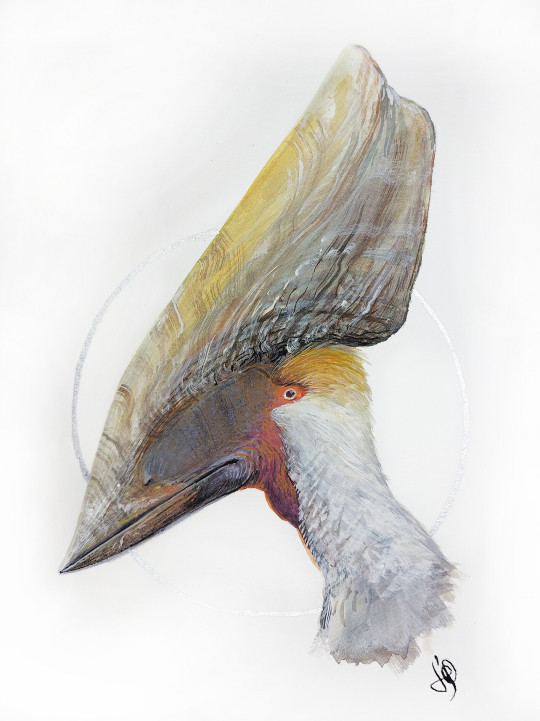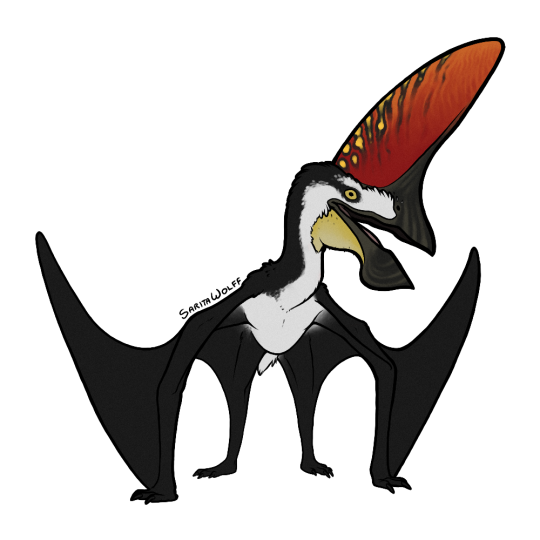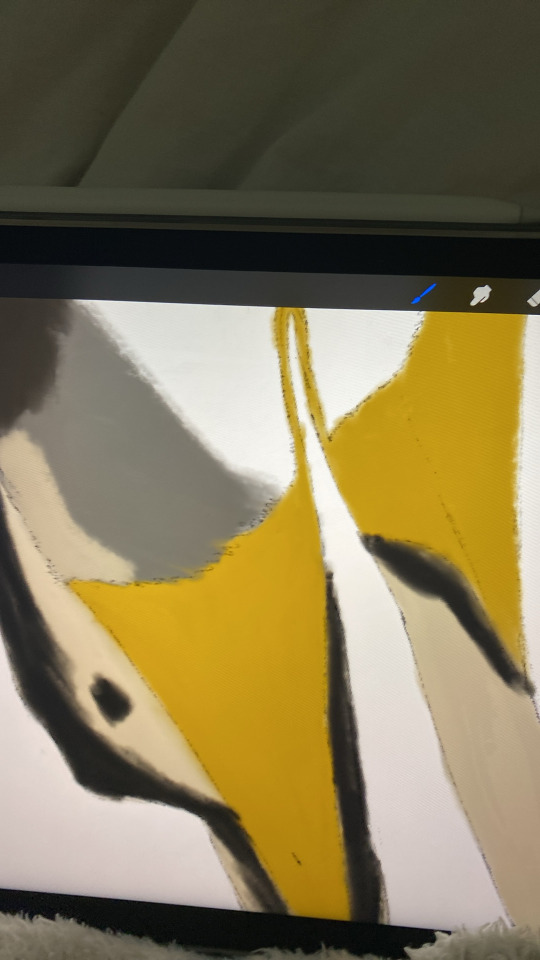#lacusovagus
Text

#is it me or are the weird dogs getting bigger#he looks hungry#should i?#should i do it?#should I give him a French fry#french fries#weird#strange#weird horse#weird dog#there’s a weird horse in my yard#weird dog series#lacusovagus#chaoyangopterid#chaoyangopteridae#azhadarchid#azhdarchidae#azhdarchoid#azhdarchid#azhdarchoidea#crato formation#night#pterosaurs but now#pterosaur post#pterosaur#avemetatarsalia#paleontology#paleoart#art#cretaceous
700 notes
·
View notes
Photo




Pterosaurs by Júlia d'Oliveira.
155 notes
·
View notes
Text

#Archovember Day 3 - Tupandactylus navigans
There were at least two species of the Tapejarid pterosaur Tupandactylus: T. imperator (who I’ve drawn previously) and T. navigans. Of the two, T. navigans is smaller, with a straighter, more upright crest. (A 2021 study suggests that the two species could actually represent sexually dimorphic members of the same species, but more detailed study is required to support this.) Either way, Tupandactylus is known for its huge keratinous crest, and T. navigans especially for its sharp shark-fin profile. This large crest likely limited T. navigans’ flight ability, relegating it to spending most of its time on the ground, only taking short flights to evade predators.
In 2022, A specimen of Tupandactylus imperator was discovered to have very complex branching pycnofibers (feather-like filaments unique to pterosaurs) that were much closer to true feathers than previously thought possible in pterosaurs. This could be further evidence that feathers are a basal trait to Avemetatarsalians. Also, similar to Anchiornis, Tupandactylus has been found with preserved melanosomes. However, paleontologists did not attempt to infer the color of the animal, but merely noted that the melanosomes were varied between the skin of the crest and the pycnofibers on its skull, probably providing some sort of contrast for the head ornamentation. No doubt imperator’s smaller cousin navigans was similar.
Living in Early Cretaceous Brazil, Tupandactylus navigans had a diverse array of frogs, lizards, and invertebrates to prey on, including moths, lacewings, mayflies, scorpions, and solifugids. T. navigans could have also preyed on small dinosaurs and their eggs, such as Enantiornithine birds and the compsognathid Ubirajara. T. navigans would have shared its environment with many other pterosaur species, such as its cousin T. imperator, Arthurdactylus, Aymberedactylus, Brasileodactylus, Lacusovagus, and Ludodactylus.

(As I’ve drawn T. imperator previously, but not with its own size chart, I’ve chosen to include it as a bonus here so the two species can be compared. I’ve also updated my imperator design a bit, as it was drawn before the 2022 study.)

#my art#SaritaDrawsPalaeo#Tupandactylus navigans#Tupandactylus#Tupandactylus imperator#tapejarid#pterodactyloid#pterosaurs#archosaurs#archosauromorph#Archovember#Archovember2023
50 notes
·
View notes
Text

Lacusovagus magnifices /// Crato Formation (Ceará, Brazil)
Continuing in on our collection of extinct fauna we have another pterosaur!
Ludodactylus (lake wanderer) is a azhdarchoid pterosaur know from a partial upper jaw fossil.
Coloration based on the jabiru stork (tuiuiuí)
94 notes
·
View notes
Text
Lacusovagus magnificens

By Joschua Knüppe, retrieved from http://www.pteros.com/, a website dedicated to education about Pterosaurs.
A reminder that we will not be able to do every pterosaur until we reach $240 in donations on our patreon, so please donate even a dollar if you can.
Name: Lacusovagus magnificens
Name Meaning: Lake Wanderer
First Described: 2008
Described By: Witton
Classification: Avemetatarsalia, Ornithodira, Pterosauromorpha, Pterosauria, Macronychoptera, Novialoidea, Breviquartossa, Pterodactylomorpha, Monofenestrata, Pterodactyliformes, Caelidracones, Pterodactyloidea, Eupterodactyloidea, Ornithocheiroidea, Azhdarchoidea, Neoazhdarchia, Neopterodactyloidea, Chaoyangopteridae
Guest post by @raptorcivilization!
Lacusovagus is another Chaoyangopterid, but interestingly enough this one comes from the Crato Formation of Ceara, Brazil, dating to the mid-late Aptian, early Cretaceous (more or less 120-122 million years ago). It’s only known from a nearly-flattened skull, but there are Chaoyangopterid neck vertebrae from the same formation that may also belong to it. Its jaws were long, toothless, and crestless. The skull was unusually wide, with “zig-zagging” sides, and probably had a fairly deep nasoantorbital fenestra behind the beak. Its wingspan is estimated at 4.1 meters, making it the largest Chaoyangopterid and one of the largest pterosaurs of the Crato Formation.
Sources:
https://www.pteros.com/pterosaurs/lacusovagus.html
https://onlinelibrary.wiley.com/doi/abs/10.1111/j.1475-4983.2008.00811.x
http://sp.lyellcollection.org/content/455/1/195
#Lacusovagus#Lacusovagus magnificens#pterosaur#Chaoyangopterid#Azhdarchoid#pterosaur ptuesday#paleontology#prehistory#prehistoric life#biology#science#nature#factfile
57 notes
·
View notes
Text

#damn he’s huge#he looked smaller before#weird horse#he’s like as tall as me#wtf#i shouldn’t#have given him a French fry#French fry#mr french fry#weird dog series#mesozoic#pterosaur#lacusovagus#don’t feed wild animals#especially#pterosaurs#paleoblr#paleoart#palaeontology#cretaceous#crato formation#chaoyangopteridae#azhadarchid#azhdarchoid
416 notes
·
View notes
Text

#don’t feed wild animals#mr french fry#keeps bothering me and my family#i’m in danger#help#please please please#uh oh#weird#weird horse#weird dog series#lacusovagus#azhadarchid#azhdarchoid#chaoyangopteridae#chaoyangopterid#pterosaur#Mesozoic#cretaceous#early cretaceous#crato formation#avemetatarsalia
43 notes
·
View notes
Text

Sneak peak of what’s coming up
#lacusovagus#chaoyangopterid#South American#pterosaur#azhadarchid#azhdarchid#azhdarchoid#I’m craving ketchup rn#pterosaurs but now#dinosaurs but now#weird dog series
3 notes
·
View notes
Text







■Brazilian extinct fauna!■
Animals included:
Ludodactylus/ Irritator/ Santanaraptor/ Lacusovagus/ Mirischia/ Cladocyclus
#paleoart#paleontology#digital art#dinosaur#paleobiology#brazilian paleoart#pterosaur#ludodactylus#irritator#santanaraptor#lacusovagus#mirischia#cladocyclus
30 notes
·
View notes